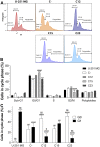Glypican-1 in human glioblastoma: implications in tumorigenesis and chemotherapy
- PMID: 32180897
- PMCID: PMC7061737
- DOI: 10.18632/oncotarget.27492
Glypican-1 in human glioblastoma: implications in tumorigenesis and chemotherapy
Abstract
Glioblastoma is one of the most common malignant brain tumors, with which patients have a mean survival of 24 months. Glypican-1 has been previously shown to be overexpressed in human glioblastoma and to be negatively correlated with patient's survival. This study aimed to investigate how glypican-1 influences the tumoral profile of human glioblastoma using in vitro cell line models. By downregulating the expression of glypican-1 in U-251 MG cells, we observed that the cellular growth and proliferation were highly reduced, in which cells were significantly shifted towards G0 as opposed to G1 phases. Cellular migration was severely affected, and glypican-1 majorly impacted the affinity towards laminin-binding of glioblastoma U-251 MG cells. This proteoglycan was highly prevalent in glioblastoma cells, being primarily localized in the cellular membrane and extracellular vesicles, occasionally with glypican-3. Glypican-1 could also be found in cell-cell junctions with syndecan-4 but was not identified in lipid rafts in this study. Glypican-1-silenced cells were much more susceptible to temozolomide than in U-251 MG itself. Therefore, we present evidence not only to support facts that glypican-1 is an elementary macromolecule in glioblastoma tumoral microenvironment but also to introduce this proteoglycan as a promising therapeutic target for this lethal tumor.
Keywords: chemotherapy resistance; glioblastoma; glypican-1; temozolomide; tumorigenesis.
Conflict of interest statement
CONFLICTS OF INTEREST The authors report no competing interests.
Figures








Similar articles
-
Neuroendocrine tumors show altered expression of chondroitin sulfate, glypican 1, glypican 5, and syndecan 2 depending on their differentiation grade.Front Oncol. 2014 Feb 7;4:15. doi: 10.3389/fonc.2014.00015. eCollection 2014. Front Oncol. 2014. PMID: 24570896 Free PMC article.
-
Effect of syndecan-1, syndecan-4, and glypican-1 on turkey muscle satellite cell proliferation, differentiation, and responsiveness to fibroblast growth factor 2.Poult Sci. 2007 Jul;86(7):1406-13. doi: 10.1093/ps/86.7.1406. Poult Sci. 2007. PMID: 17575189
-
Developmental and cell-type-specific expression of cell surface heparan sulfate proteoglycans in the rat heart.Exp Cell Res. 1997 Jan 10;230(1):145-53. doi: 10.1006/excr.1996.3400. Exp Cell Res. 1997. PMID: 9013716
-
Discovery and diagnostic value of a novel oncofetal protein: glypican 3.Adv Anat Pathol. 2014 Nov;21(6):450-60. doi: 10.1097/PAP.0000000000000043. Adv Anat Pathol. 2014. PMID: 25299314 Review.
-
Present and potential future adjuvant issues in high-grade astrocytic glioma treatment.Adv Tech Stand Neurosurg. 2009;34:3-35. doi: 10.1007/978-3-211-78741-0_1. Adv Tech Stand Neurosurg. 2009. PMID: 19368079 Review.
Cited by
-
Attenuation of cancer proliferation by suppression of glypican-1 and its pleiotropic effects in neoplastic behavior.Oncotarget. 2023 Mar 21;14:219-235. doi: 10.18632/oncotarget.28388. Oncotarget. 2023. PMID: 36944188 Free PMC article.
-
Infrared Microspectroscopy and Imaging Analysis of Inflammatory and Non-Inflammatory Breast Cancer Cells and Their GAG Secretome.Molecules. 2020 Sep 19;25(18):4300. doi: 10.3390/molecules25184300. Molecules. 2020. PMID: 32961706 Free PMC article.
-
Chemotherapy-Induced Degradation of Glycosylated Components of the Brain Extracellular Matrix Promotes Glioblastoma Relapse Development in an Animal Model.Front Oncol. 2021 Jul 19;11:713139. doi: 10.3389/fonc.2021.713139. eCollection 2021. Front Oncol. 2021. PMID: 34350124 Free PMC article.
-
Agents for Fluorescence-Guided Glioblastoma Surgery.Pharmaceutics. 2025 May 11;17(5):637. doi: 10.3390/pharmaceutics17050637. Pharmaceutics. 2025. PMID: 40430928 Free PMC article. Review.
-
The anti-glypican 1 AT101 antibody as targeting agent to effectively deliver chitosan nanobubbles to glioblastoma cells.Nanomedicine (Lond). 2025 Jan;20(1):23-36. doi: 10.1080/17435889.2024.2434451. Epub 2024 Dec 2. Nanomedicine (Lond). 2025. PMID: 39620421
References
-
- Louis DN, Perry A, Reifenberger G, von Deimling A, Figarella-Branger D, Cavenee WK, Ohgaki H, Wiestler OD, Kleihues P, Ellison DW. The 2016 World Health Organization Classification of Tumors of the Central Nervous System: a summary. Acta Neuropathol. 2016; 131:803–20. 10.1007/s00401-016-1545-1. - DOI - PubMed
LinkOut - more resources
Full Text Sources

